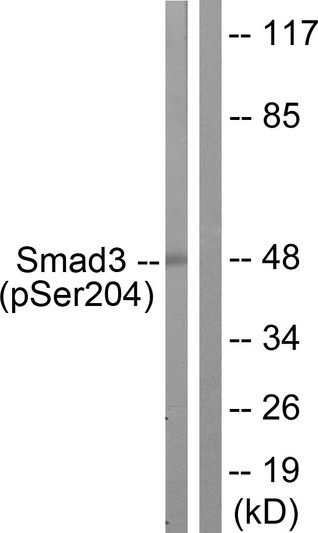| Host: | Rabbit |
| Applications: | WB/IHC/IF/ELISA |
| Reactivity: | Human/Mouse/Rat |
| Note: | STRICTLY FOR FURTHER SCIENTIFIC RESEARCH USE ONLY (RUO). MUST NOT TO BE USED IN DIAGNOSTIC OR THERAPEUTIC APPLICATIONS. |
| Short Description : | Rabbit polyclonal antibody anti-Phospho-Mothers against decapentaplegic homolog 3-Ser204 (170-219 aa) is suitable for use in Western Blot, Immunohistochemistry, Immunofluorescence and ELISA research applications. |
| Clonality : | Polyclonal |
| Conjugation: | Unconjugated |
| Isotype: | IgG |
| Formulation: | Liquid in PBS containing 50% Glycerol, 0.5% BSA and 0.02% Sodium Azide. |
| Purification: | The antibody was affinity-purified from rabbit antiserum by affinity-chromatography using epitope-specific immunogen. |
| Concentration: | 1 mg/mL |
| Dilution Range: | WB 1:500-1:2000IHC 1:100-1:300IF 1:200-1:1000ELISA 1:20000 |
| Storage Instruction: | Store at-20°C for up to 1 year from the date of receipt, and avoid repeat freeze-thaw cycles. |
| Gene Symbol: | SMAD3 |
| Gene ID: | 4088 |
| Uniprot ID: | SMAD3_HUMAN |
| Immunogen Region: | 170-219 aa |
| Specificity: | Phospho-Smad3 (S204) Polyclonal Antibody detects endogenous levels of Smad3 protein only when phosphorylated at S204. |
| Immunogen: | The antiserum was produced against synthesized peptide derived from the human Smad3 around the phosphorylation site of Ser204 at the amino acid range 170-219 |
| Function | Receptor-regulated SMAD (R-SMAD) that is an intracellular signal transducer and transcriptional modulator activated by TGF-beta (transforming growth factor) and activin type 1 receptor kinases. Binds the TRE element in the promoter region of many genes that are regulated by TGF-beta and, on formation of the SMAD3/SMAD4 complex, activates transcription. Also can form a SMAD3/SMAD4/JUN/FOS complex at the AP-1/SMAD site to regulate TGF-beta-mediated transcription. Has an inhibitory effect on wound healing probably by modulating both growth and migration of primary keratinocytes and by altering the TGF-mediated chemotaxis of monocytes. This effect on wound healing appears to be hormone-sensitive. Regulator of chondrogenesis and osteogenesis and inhibits early healing of bone fractures. Positively regulates PDPK1 kinase activity by stimulating its dissociation from the 14-3-3 protein YWHAQ which acts as a negative regulator. |
| Protein Name | Mothers Against Decapentaplegic Homolog 3Mad Homolog 3Mad3Mothers Against Dpp Homolog 3Hmad-3Jv15-2Smad Family Member 3Smad 3Smad3Hsmad3 |
| Database Links | Reactome: R-HSA-1181150Reactome: R-HSA-1502540Reactome: R-HSA-2173788Reactome: R-HSA-2173789Reactome: R-HSA-2173795Reactome: R-HSA-2173796Reactome: R-HSA-3304356Reactome: R-HSA-3311021Reactome: R-HSA-3315487Reactome: R-HSA-3656532Reactome: R-HSA-5689880Reactome: R-HSA-8941855Reactome: R-HSA-8952158Reactome: R-HSA-9008059Reactome: R-HSA-9013695Reactome: R-HSA-9615017Reactome: R-HSA-9617828Reactome: R-HSA-9735871Reactome: R-HSA-9754189Reactome: R-HSA-9796292Reactome: R-HSA-9823730Reactome: R-HSA-9839394 |
| Cellular Localisation | CytoplasmNucleusCytoplasmic And Nuclear In The Absence Of Tgf-BetaOn Tgf-Beta StimulationMigrates To The Nucleus When Complexed With Smad4Through The Action Of The Phosphatase Ppm1aReleased From The Smad2/Smad4 ComplexAnd Exported Out Of The Nucleus By Interaction With Ranbp1Co-Localizes With Lemd3 At The Nucleus Inner MembraneMapk-Mediated Phosphorylation Appears To Have No Effect On Nuclear ImportPdpk1 Prevents Its Nuclear Translocation In Response To Tgf-BetaLocalized Mainly To The Nucleus In The Early Stages Of Embryo Development With Expression Becoming Evident In The Cytoplasm Of The Inner Cell Mass At The Blastocyst Stage |
| Alternative Antibody Names | Anti-Mothers Against Decapentaplegic Homolog 3 antibodyAnti-Mad Homolog 3 antibodyAnti-Mad3 antibodyAnti-Mothers Against Dpp Homolog 3 antibodyAnti-Hmad-3 antibodyAnti-Jv15-2 antibodyAnti-Smad Family Member 3 antibodyAnti-Smad 3 antibodyAnti-Smad3 antibodyAnti-Hsmad3 antibodyAnti-SMAD3 antibodyAnti-MADH3 antibody |
Information sourced from Uniprot.org













